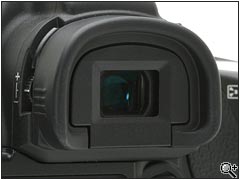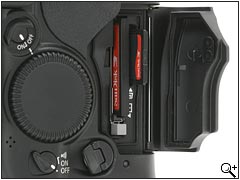The new Canon
EOS-1D Mark II is the successor to the Canon EOS-1D which was
announced and introduced at the end of 2001. This new generation
of digital SLR almost doubles resolution with its new eight
megapixel CMOS sensor, doubles the size of the continuous
shooting buffer, which enables the camera to shoot at 8.5 fps
for up to 40 shots.
 The
EOS-1D Mark II is also obviously Canon's answer to Nikon's fast
shooting D2H announced last year, it does appear however as
though Canon are raising the bar with resolution. Putting the
additional resolution and buffer size to one side there are also
a variety of improvements and changes compared to the EOS-1D,
not least of which a new version of Canon's DIGIC image
processor, an extension of selectable ISO sensitivity, support
for Secure Digital as well as Compact Flash and the addition of
a USB port. The physical design of the
EOS-1D Mark II is almost identical to the EOS-1D (and EOS-1Ds).
The only noticeable differences are a slight pinch of the body
around the viewfinder prism, the removal of the external white
balance sensor and the addition of a third button below the rear
LCD panel.
The
EOS-1D Mark II is also obviously Canon's answer to Nikon's fast
shooting D2H announced last year, it does appear however as
though Canon are raising the bar with resolution. Putting the
additional resolution and buffer size to one side there are also
a variety of improvements and changes compared to the EOS-1D,
not least of which a new version of Canon's DIGIC image
processor, an extension of selectable ISO sensitivity, support
for Secure Digital as well as Compact Flash and the addition of
a USB port. The physical design of the
EOS-1D Mark II is almost identical to the EOS-1D (and EOS-1Ds).
The only noticeable differences are a slight pinch of the body
around the viewfinder prism, the removal of the external white
balance sensor and the addition of a third button below the rear
LCD panel.
The body is based around the EOS-1V's original design and has an
extraordinary solid robust feel about it, as I noted in my
previous review s
it really does feel as though it is hewn from a solid block of
metal. Rubber seals around compartment doors and rubber grommets
around all controls hint further at its robust and weatherproof
design. It doesn't get much more 'professional' than this.
s
it really does feel as though it is hewn from a solid block of
metal. Rubber seals around compartment doors and rubber grommets
around all controls hint further at its robust and weatherproof
design. It doesn't get much more 'professional' than this.
Handling
The EOS-1D Mark II has fully integrated design with a manageable
control structure which tends towards avoiding accidental
settings changes (a must for professional photographers). This
means that most settings changes / navigation require the use of
a button and command dial. The quick control dial dominates the
rear of the camera and provides control over LCD functions as
well as exposure compensation and aperture selection in Manual
exposure mode.
Both hand grips are deep and well design (being based on the
EOS-1V) with a distinctive middle finger recess. In your hand
the camera feels weighty but well balanced and extremely solid.
The depth of the recessed 'lip' at the top of the hand grip
provides a vital key for locating the correct grip as well as
providing additional grip ability.
 The
Mark II has a bright and and clear viewfinder which provides a
good field of view (the 1.3x crop isn't as noticeable as a
1.6x). The Mark II's viewfinder has a simple dioptre adjustment
wheel and an eye point of 20 mm (0.8 in) which is the distance
it protrudes from the rear of the camera.
The
Mark II has a bright and and clear viewfinder which provides a
good field of view (the 1.3x crop isn't as noticeable as a
1.6x). The Mark II's viewfinder has a simple dioptre adjustment
wheel and an eye point of 20 mm (0.8 in) which is the distance
it protrudes from the rear of the camera.
The EOS-1D Mark II uses the same 45-point area AF CMOS sensor
used in the EOS-1D/1Ds, it measures 15 x 8 mm and is located
just below the semitransparent mirror and receives the exact
same image you see through the viewfinder. All AF points are
sensitive to horizontal detail, however for a lens with a
maximum aperture of F2.8 or faster lens a vertical row of 7
points (as indicated in red in the diagram above, right) become
sensitive to both horizontal and vertical detail, and the manual
notes, are three times more sensitive than the normal horizontal
sensors. Some other L lenses with maximum apertures of F4 or
brighter make use of the centre cross-type AF point.
Having 45 focusing points isn't just about being able to choose
your focus area within the image it also means that focus
tracking (AI Servo) can be much more effective.
Storage
The storage compartment is situated on the back of the hand
grip. The compartment door is spring loaded and 'pops open' as
soon as you turn the knob (note that this has been made easier
to operate, especially useful if you're wearing gloves).
 You
can close the door and pick up the camera in one movement. If
you take a closer look at this images below you will see the
rubber environmental seal around the inside of the compartment
door. Behind the compartment door you will find two storage
slots, one for Compact Flash (Type I/II, Microdrive and FAT32
support) and one for Secure Digital cards.
You
can close the door and pick up the camera in one movement. If
you take a closer look at this images below you will see the
rubber environmental seal around the inside of the compartment
door. Behind the compartment door you will find two storage
slots, one for Compact Flash (Type I/II, Microdrive and FAT32
support) and one for Secure Digital cards.
Looking at the rear on the left we have a group of 'digital
controls' surrounding the two inch LCD monitor, below this
there's a status LCD which again shows information which
pertains to the digital side of the camera. On the right is the
familiar quick control dial (which can be disabled in record
mode but is always active in display or menus), power switch and
CF compartment release knob. The Mark II has an integrated
vertical hand grip which runs the length of the base of the
camera. There are a number of controls repeated on the vertical
grip (in addition to the shutter release): main dial, FEL
button, AE Lock button, AF Assist button and the AF point
selection button. These controls are normally disabled and can
be enabled by turning the vertical grip activation switch (great
name) to 'ON'
 Conclusion
Conclusion
The first thing you'll notice about the Mark II is its
physical presence. Equipped with battery, CF memory card and
Canon EF 24-70 f2.8L zoom lens, it tips the scales at just over
five pounds. Although you'll feel its weight during extended
use, the Mark II is extremely well balanced. The rugged
all-metal body is also quite large, measuring 6.1 x 6.2 x 3.1
inches. But the size of the body is actually a benefit,
providing enough space for the logical and ergonomic location of
its various buttons and controls. The body is also well sculpted
for comfortable hand-holding in both landscape and portrait
orientation. All of the Mark II's covers fit snugly and seem
capable of withstanding the rigors of professional use. The
switches and other controls have a positive, professional feel.
Image quality wise there are no complaints with the
EOS-1D Mark II, it's certainly no point-and-shoot camera and
requires a certain amount of experimentation and learning before
reaching your idea of the perfect image. That's also the
camera's advantage, taking a hands-off approach to image
development means that the photographer gets to decide just how
the final image will look.
With its 8-megapixel imager, accurate autofocus system, precise
metering system and robust performance the Canon EOS-1D Mark II
is photographic tool that is unrivalled in the industry at the
time of writing.